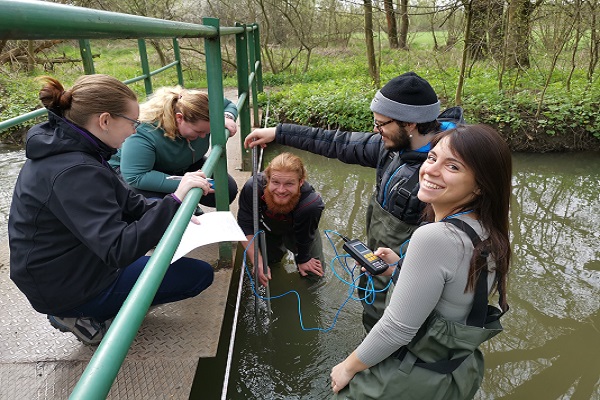1. Introduction to the issue. Basic concepts and relationships describing the behavior and fate of chemicals in the environment (environmental interface and chemical balance, persistence in the environment, environmental equilibria, transport in components and between components of the environment).
2. Chemical and biochemical processes taking place in nature. Bioaccumulation, bioenrichment, biodegradation, biotransformation.
3. Introduction to the study of the origin of reactions, transport, influencing and extinction of chemical substances in the atmosphere, soil and water and human influence on these processes. Substance flows in the environment - natural and anthropogenically influenced
4. Basic physico-chemical properties of substances and environmental-chemical properties of individual components of the environment influencing the fate of substances in the environment. Possibilities of limiting the entry of contaminants into the environment and their elimination.
5. Basic processes influencing the fate of chemical substances in the environment (sorption, accumulation,…), transport processes of chemical substances in individual components of the environment (movement in the atmosphere, hydrosphere, pedosphere and biosphere).
6. Basic transformation processes in the environment (oxidation and reduction, photochemical reactions, hydrolysis, biotransformation ..).
7. Distribution of substances in the environment, phase equilibria and interfacial transitions. Modeling the fate and distribution of chemicals in the environment at the local, regional and global levels.
8. Biogeochemical cycles: main elements C, O, N, P, S, K, Fe, Mn, Ca, Al, trace elements; The movement of chemical elements between organisms and inanimate parts of the atmosphere, lithosphere and hydrosphere
9. Lithosphere - definition, composition; substance flows, physical and chemical processes.
10. Pedosphere - definition, composition, substance flows; chemical, physico-chemical processes. Soil pollution - primary, secondary, metals, nutrients, organic pollutants. Biosphere - basic characteristics, exposure of organisms, its consequences.
11. Hydrosphere - definition, hydrological cycle - material flows, chemical, physico-chemical processes; anthropogenic influences. Pollution of the hydrosphere. Water and its function, chemical composition, hydrological cycle. Types of pollution: petroleum substances, detergents, radioactive substances, inorganic and organic pollutants, artificial fertilizers, pesticides.
12.Atmosphere - definition, composition, substance flows, physical, chemical, physico-chemical processes. Atmospheric pollution. Basic properties of the atmosphere related to the dispersion of pollutants (temperature stratification, temperature, pressure, humidity). Natural chemical composition of the atmosphere.
13. Atmosphere - Pollutants, emissions, immissions, transport and dispersion of pollutants, sources of pollution in terms of origin, distribution and time. Primary and secondary pollution, values of NPK, Kmax, Kd. Reactions of pollutants in the atmosphere, photochemical reactions. Smog oxidizing and reducing.
2. Chemical and biochemical processes taking place in nature. Bioaccumulation, bioenrichment, biodegradation, biotransformation.
3. Introduction to the study of the origin of reactions, transport, influencing and extinction of chemical substances in the atmosphere, soil and water and human influence on these processes. Substance flows in the environment - natural and anthropogenically influenced
4. Basic physico-chemical properties of substances and environmental-chemical properties of individual components of the environment influencing the fate of substances in the environment. Possibilities of limiting the entry of contaminants into the environment and their elimination.
5. Basic processes influencing the fate of chemical substances in the environment (sorption, accumulation,…), transport processes of chemical substances in individual components of the environment (movement in the atmosphere, hydrosphere, pedosphere and biosphere).
6. Basic transformation processes in the environment (oxidation and reduction, photochemical reactions, hydrolysis, biotransformation ..).
7. Distribution of substances in the environment, phase equilibria and interfacial transitions. Modeling the fate and distribution of chemicals in the environment at the local, regional and global levels.
8. Biogeochemical cycles: main elements C, O, N, P, S, K, Fe, Mn, Ca, Al, trace elements; The movement of chemical elements between organisms and inanimate parts of the atmosphere, lithosphere and hydrosphere
9. Lithosphere - definition, composition; substance flows, physical and chemical processes.
10. Pedosphere - definition, composition, substance flows; chemical, physico-chemical processes. Soil pollution - primary, secondary, metals, nutrients, organic pollutants. Biosphere - basic characteristics, exposure of organisms, its consequences.
11. Hydrosphere - definition, hydrological cycle - material flows, chemical, physico-chemical processes; anthropogenic influences. Pollution of the hydrosphere. Water and its function, chemical composition, hydrological cycle. Types of pollution: petroleum substances, detergents, radioactive substances, inorganic and organic pollutants, artificial fertilizers, pesticides.
12.Atmosphere - definition, composition, substance flows, physical, chemical, physico-chemical processes. Atmospheric pollution. Basic properties of the atmosphere related to the dispersion of pollutants (temperature stratification, temperature, pressure, humidity). Natural chemical composition of the atmosphere.
13. Atmosphere - Pollutants, emissions, immissions, transport and dispersion of pollutants, sources of pollution in terms of origin, distribution and time. Primary and secondary pollution, values of NPK, Kmax, Kd. Reactions of pollutants in the atmosphere, photochemical reactions. Smog oxidizing and reducing.
